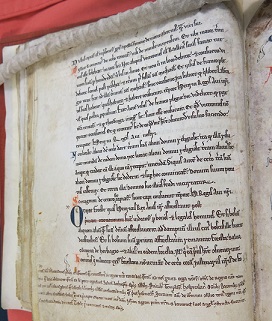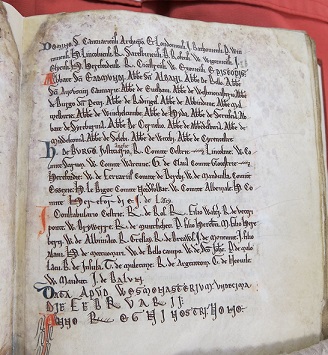The Cerne Abbey Magna Carta
April 2014,
One of the aims of the Magna Carta project is to find copies of Magna Carta made in the first century of its existence. The search is ongoing, but around a hundred have so far been located. These include copies of the 1215, 1216, 1217 and 1225 Charters, the two last usually linked with copies of the Charter of the Forest. There are a few single sheet examples, but, in the main, the copies are found written into chronicles, cartularies, and, most plentifully of all, unofficial collections of legal material, sometimes called by historians ‘statute books’. Many of the 1225 copies are found within later confirmations, especially those of Edward I in 1297 and 1300. It is hoped to present much fuller chapter and verse on these findings in due course. The purpose here is to draw attention to a fascinating copy of the 1225 Charters in the Cartulary of Cerne Abbey in Dorset. Here Magna Carta and the Charter of the Forest are joined together and converted into a single Charter! Later, however, someone at Cerne disapproved of this artifice and inserted the conclusion of Magna Carta in its proper place, only to spoil the scholarly effect by using not the end of 1225 Charter, but that of the Charter of 1217 instead. The Cerne copy has one other point of interest for it writes out the witnesses and date of the 1225 Charter in uniquely magnificent fashion.
The folios which form what is called the Cerne cartulary are bound up in a liturgical volume known as The Book of Cerne, which is now preserved in the Cambridge University Library.1 When the cartulary was printed in the proceedings of the splendidly named Dorset Natural History and Antiquarian Field Club, the editor omitted the Great Charter and Charter of the Forest (he did not say which versions they were) on the grounds that the texts had been ‘fully printed and translated elsewhere’.2 How often do such statements prove misleading.
The copies of the Charters in the Cartulary were made in a clear and, to my eye, beautiful hand, which seems perfectly compatible with date in or soon after 1225. The same scribe goes on to transcribe other material from that year. His copy of Magna Carta itself is accurate enough all the way down to the last chapter, which is that on scutage. Then, however, the scribe omitted the concluding clauses, those which saved everyone’s pre-existing liberties, insisted that the king’s concessions be passed down, acknowledged that the Charter had been issued in return for taxation, and prevented the king from doing anything to invalidate his concessions. The scribe also omitted the long witness list and the place and date of the Charter’s issue. He could do so because, having studied the documents, he knew that all these would come again at the end of the Charter of the Forest.
Into the Charter of the Forest, accordingly the scribe now plunged. He omitted the preamble, since it was indentical to that in Magna Carta, which he had already copied. He also omitted the ‘in primis’ at the start of the first chapter. It was, after all, no longer ‘in primis’. Instead, he began with the next word ‘omnes’ - ‘all the forests’ which had been afforested by Henry II were to be deforested. Initially, the scribe made the painted ‘O’ in ‘omnes’ exactly the same size as the ‘O’ at the start of his chapters in Magna Carta. The only clue that a new section was beginning came in the ‘omnes’ being in capital letters. Almost at once, however, the scribe had second thoughts. He rubbed out the ‘O’ and wrote a bigger one, which indented the line below so that the text had to be written around it. That it was written around, with no sign of erasures, shows the change was made before the scribe continued with the chapter.3 Still, although the large ‘O’ indicated a division, it did not really alter the fact that Magna Carta and the Forest Charter had now been run together.
Why did the scribe act in this way? Clearly he wished to avoid having to write out the same material twice, but why not simply say that the beginning and end of the Forest Charter were the same as Magna Carta? The answer, I would suggest, is that the scribe shied away from anything which might diminish the status of the Forest Charter. The forest was a major issue in Dorset. The very next document the scribe copied out was the forest perambulation in the county commissioned in 1225.4 Another way of shortening the work of copying the Charters, often adopted, was to leave out the witnesses. This the Cerne scribe absolutely refused to do. On the contrary, he wrote out the witness list in elaborate fashion, dividing up, bishops, abbots, earls, and barons, and decorating the whole with the occasional illuminated letter. Clearly, he appreciated the significance of the witness list in placing the 1225 Charters on an altogether new footing from their predecessors. The earlier Charters, after all, had contained no witness lists to speak of. Now in 1225, large numbers of bishops, abbots, earls, and barons, the last two both loyalists and former rebels, came together in support of the Charter. No wonder the scribe felt moved to celebrate the date of this great event, writing it out in capitals: DATA APUD WESTMONASTERIUM UNDECIMA DIE FEBRUARII ANNO REGNI NOSTRI NONO. He had transformed what in the engrossments and in the copies (if it appeared at all) seemed a boring list of names into something rich and full of meaning.
It seems a shame that someone came along to spoil the omnibus Charter which Cerne had created. As can be seen from the first image given above, at the bottom of the folio with the scutage chapter, a different hand has inserted the passages about passing down the concessions, saving everyone’s existing liberties, and destroying the castles built in the civil war, which came at the end of the Charter of 1217. The new scribe also included 1217’s statement that the witnesses are as named before, which referred not to any one named at the start of the 1225 Charter but to those who appear at the start of the Charter of 1217. There is no reference, however, to the sealing of the Charter by the legate and the regent.
It has long been known that many copies of Henry III’s Magna Carta are in fact conflations of the Charters of 1217 and 1225. Here one can see a conflation in the actual course of creation. Had a copy of Magna Carta been made from the Cerne cartulary, it might simply have begun as 1225 and ended as 1217, thus concealing its origins. Just when the addition was made at Cerne, we did not know, although the hand looks more early than late thirteenth century.5 That anyone bothered to edit the Charter shows, of course, its continuing appeal. Here, there was a parallel at St Albans, where Matthew Paris, once he obtained an authentic copy of the 1215 Charter, made valiant efforts to correct Roger of Wendover’s conflated version, which included passages from 1215, 1217 and 1225.6 The result, as at Cerne, was as much to cloud as clarify the issue. Yet the confusion was the result of the very success of the Charters. Clearly copies of the various versions were readily available. Clearly too, Cerne and St Albans were interested in the detail, not just the general principles. Indeed, in the Cerne copy, as in many others, hands and marginal annotations drew attention to particular chapters. This interest in the detail was one of the strands which wove the Charters into the fabric of English life.
1 | Cambridge University Library Ll, 1-10, fos.9v-15r. |
2 | ‘The Cartulary of Cerne Abbey’, Proceedings of the Dorset Natural History and Antiquarian Field Club, ed. H. Pentin, xxix (1908), 195-204, at 195. |
3 | The clerk put in ‘post primam coronationem suam’ here and then rightly crossed it out as it appears not here but in chapter 3. |
4 | ‘Cerne Cartulary’, 195-7. |
5 | Teresa Webber tells me it could date to soon after 1225. |
6 | J.C. Holt, ‘The St Albans Chroniclers and Magna Carta’, chapter 12 of his Magna Carta and Medieval Government (London, 1985), 277-87. Holt’s article (reprinted from Transactions of the Royal Historical Society, 5th series, xiv (1964), 67-88) seems to me too critical of Paris. For a different view, see S. Reynolds, ‘Magna Carta 1297 and the legal use of literacy’, Historical research, 62 (1989), 241 and note 54. |
- January 2016
Exchange of Letters between King and Rebels - December 2015
Partridges and a Pear Tree - December 2015
The Saving Clause in Magna Carta - December 2015
Christ's College and Magna Carta - November 2015
The Arms of Roger Bigod - October 2015
Ten Letters on Anglo-Papal Diplomacy - September 2015
The Leges Edwardi Confessoris - July 2015
New Letter of the Twenty-Five - July 2015
Runnymede and the Commemoration of Magna Carta - June 2015
Who Did (and Did Not) Write Magna Carta - June 2015
Date of Magna Carta - June 2015
A Lost Engrossment of 1215? - May 2015
A Glimpse of Rebel London - May 2015
The Rebel Seizure of London - May 2015
Papal Letters of 19 March - May 2015
The Copies at Lincoln and Salisbury of the 1215 Magna Carta - May 2015
The copies of Magna Carta 1216 - May 2015
The Magna Carta of Cheshire - April 2015
Dating the Outbreak of Civil War - April 2015
More from the Painter Archive - April 2015
A Magna Carta Relic in Pennsylvania - April 2015
A Lost Short Story by Sidney Painter - April 2015
King John's Banners and Battle Flags - March 2015
King John’s Lost Language of Cranes - March 2015
Magna Carta and Richard II's Reign - March 2015
The King Takes the Cross - February 2015
Irish Fines and Obligations - January 2015
John negotiates with Langton over Rochester - January 2015
Conference at New Temple - December 2014
Simon de Montfort's Changes to Magna Carta - November 2014
Meeting at Bury St Edmunds - October 2014
King John Forgets his Password - September 2014
Treaty 18 September 1214 - September 2014
Letter of King John 9 July 1214 - September 2014
Letter of Aimery Vicomte of Thouars - August 2014
The Freedom of Election Charter - July 2014
The Witness Lists to Magna Carta - April 2014
The Cerne Abbey Magna Carta - March 2014
Confirmation of Magna Carta in 1265

